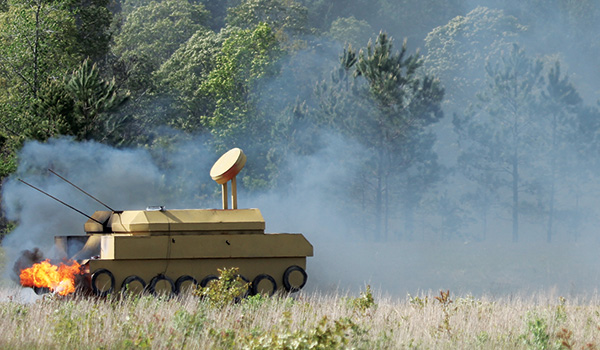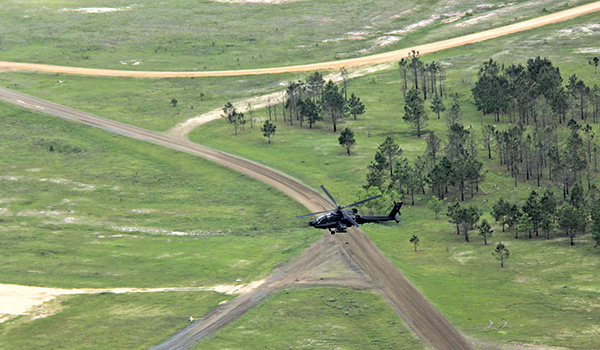
Joint Readiness Training Center / By LTC Bryan Chivers and MAJ Adam Camarano: The Attack has long been the defining offensive task for Army Aviation. Today we find ourselves in an interesting transition period where current conflict calls for maintaining proficiency in the current era of team tactics while the Army focuses on training for the decisive action fight, a more deliberate employment of AH-64s at the platoon and higher level. Maintaining proficiency in two distinctly different mission sets is an incredible challenge, and commanders must strike a delicate balance between training for the current fight and being prepared to meet emerging threats. This emphasizes the importance of why home station training for the deliberate attack is so crucial.

Task Force TALON AH-64D crew destroying targets during JRTC Rotation 16-06./ALL PHOTOS U.S. ARMY PHOTO BY SCOTT GIBSON JRTC VIDEOGRAPHER
Observations of Aviation task forces at the Joint Readiness Training Center (JRTC) show an overall lack of proficiency in planning and executing offensive operations. A generation of officers that have only known and experienced combat in Iraq and Afghanistan largely attributed to this. In order to bridge the experience gap and re-invigorate training towards company level offensive operations, JRTC Aviation Division introduced a training event designed specifically to train rotational task forces on the planning and execution of the deliberate attack.
Deliberate Attack Training Event
In the JRTC scenario, the Aviation Task Force is given a mission to attack an enemy marshalling area and air defense facility in order to set the conditions for the rotational brigade combat team joint forcible entry operations. The training event is designed to provide the aviation task force an opportunity to conduct deliberate planning and execution focused on the engagement area development steps. It is specifically designed to reinforce the most common challenges of attack planning: intelligence preparation of the battlefield, integrating the engagement area, direct fire planning, and fire control. The ultimate goal of the JRTC training event is to develop a basic level of understanding to successfully execute a deliberate attack during the rotation and achieve a bench mark to train at home station following the rotation.

1-509th Parachute Infantry Regiment OPFOR Soldiers (Geronimo) employing the MAST system during JRTC Rotation 16-06.
With a little bit of creativity and use of training aids, training for the deliberate attack is relatively easy and inexpensive to train at home station. There is a multitude of resources to assist the S3 in building a complete training vignette or extended scenario. The Army Aviation Training Strategy (22 January 2016) describes available resources for training scenarios and lays out an example Live/Virtual/Gaming-Constructive training concept. Additionally, the TRADOC G-27 Operational Environment Training Support Center provides a complete suite of web-based training tools, to include a repository of training support packages and vignettes, as well as the Virtual OPFOR academy that provides information to learn and replicate OPFOR counter tasks to achieve unit training objectives. A dual-pronged approach and focused training effort can create a gated training strategy to build towards battalion level proficiency and beyond. By focusing on the staff and the companies simultaneously in a nested training plan, the battalion can move towards a culminating training validation.
Staff Planning and Company Battle Drill
Units should initially build the basic level of proficiency using the staff and company level Combined Arms Training Strategy Tasks. During this phase the battalion staff focuses on steps one through three of the engagement area development. A successful scenario construct requires the commander, S2, and S3 to develop a framework for the operation to include defining the enemy through a background narrative to describe the road to war and a doctrinal template that facilitates unit training objectives. Once the construct is established, the staff can execute an engagement area development planning exercise. During this planning exercise the staff conducts intelligence preparation of the battlefield, selects the ground for the attack, and integrates the engagement area with the goal of producing the plan. During this step, the companies conduct battle drill rehearsals, leveraging the Aviation Combined Arms Tactical Trainer (AVCATT), and live execution to refine and build proficiency in drills such as battle position selection and occupation, masking/unmasking procedures, manned/unmanned teaming training, call for fire, and basic gunnery skills. This phase should culminate with a staff and aircrew terrain walk of the engagement area in the local training area to validate the S2’s terrain analysis and the staff’s integration of the engagement area. By physically walking the terrain, the participants achieve a true appreciation of the effects of vegetation and micro terrain battlefield geometry that does not manifest itself by looking at map or computer products.
Company Level Direct Fire Planning/Execution
Upon completion of the staff planning and company battle drill phase, the training transitions to company level focus on direct fire planning. The newly released ATP 3-04.1, Aviation Tactical Employment, outlines this process in detail and highlights the necessity for the battalion commander and staff involvement in the bottom up refinement by the company planners. Upon order production by the company planning cells, the focus shifts to rehearsals to ensure all crew members understand the plan. Prior to live execution, the commander should validate his planning and battle drill training through AVCATT rehearsals. The AVCATT can facilitate the virtual training environment to conduct the operations as well as allow leaders to observe real-time all aspects of the mission with minimal cost. It’s also a great AAR and retraining tool prior to live execution.

Task Force TALON AH-64D crew maneuvering while executing a deliberate attack during JRTC Rotation 16-06.
After successfully passing the planning and rehearsal gates, the company is ready for live execution. Commanders should prioritize the training event to focus the battalion and company to maximize the training for the battalion. The battalion can accomplish a holistic training event by incorporating the staff to facilitate mission command, the FARP to arm and fuel the aircraft, and adjacent companies as observers and opposition forces. The key component to live execution is the incorporation of objective grading criteria to facilitate after action reviews and identify areas that need retraining. The grading criteria should serve a dual purpose to validate the planning and execution. Criteria such as time spent in battle position, time to acquire targets, percentage of targets hit, and number of targets engaged multiple times develop valuable lessons learned and lead to more refined planning and battle drills. The analysis of gun tapes and observers to gather after action review data greatly increases the productivity of the after action review (AAR) and illuminates tangible discussion points.
Adding Levels of Complexity
As proficiency grows at the platoon and company level units can add greater levels of complexity to build on the foundation and increase the level of integration with maneuver units, fires, close air support, unmanned aircraft systems (UAS), and threat. Combined arms integration and manned-unmanned teaming can easily be replicated in the AVCATT through linking the system to the Close Combat Tactical Trainer and UAS universal mission simulator. Units should include threat replication to increase complexity and enforce repercussions to poor tactics exposed during execution. The Man-Portable Aircraft Survivability Trainer (MAST) is a training device to replicate man-portable air defense threats that both stimulate the aircraft common missile warning system and records engagements for playback during the AAR. The MAST is used extensively at the Joint Readiness Training Center and provides excellent feedback to aircrews on the effectiveness of their tactics.
Training the deliberate attack is an effective way to build combat skills that will ensure the AH-64’s lethality across all operations. The proficiency gained by massing and coordinating fires on targets ensures that the tremendous capabilities of attack aviation can shape the fight in favor of the ground force commander.
No Slack! All the Way!
LTC Bryan Chivers is the senior aviation trainer and MAJ Adam Camarano is the senior command post trainer at the Joint Readiness Training Center, Ft. Polk, LA.










